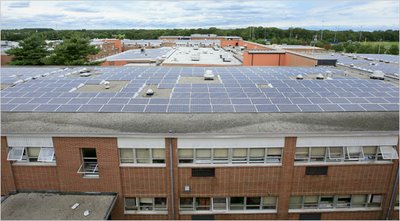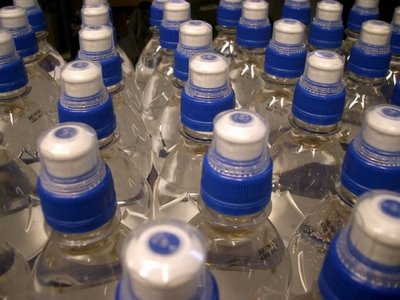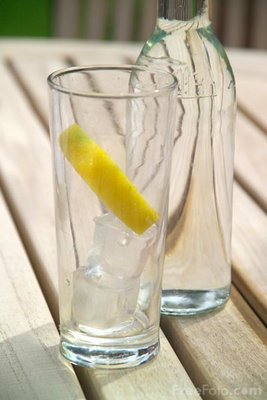Let us for a time turn our gaze from Washington, dear reader. It is a depressing view.
We at The Thin Green Line have written quite a lot about solar energy and other alternative forms of energy like geo-thermal and wind power.
What is encouraging to note is that as we scan the information landscape about these subjects, primarily in other newspapers around the country, we find increasingly that the subject is not dealt with in special "environmental" sections of the paper or Web sites, but rather in the "business" section.
We are becoming convinced that this is because green building practices and practices of sustainability are increasing in popularity not because of marketing, or because of some sense of moral obligation on people's part, but because it makes sense -- period.
Back in
June, The New York Times ran a story about how high fuel prices were making the old suburban ideal of the big-house-with-the-cathedral-ceiling-in-the-big-subdivision-at-the-new-exit-off-the-big-highway harder to sustain.
Of course, since then the housing market has collapsed (or perhaps, in part, because of that) and there are all sorts of reasons why the building of such megaliths has stalled.
But the underlying conflict remains.
People like us who read planning journals call living an hour or two away from the city or town in which you work so you can live "in the country," living in an -exurb or "on the fringe." It's like a suburb on steroids. Twice the square footage, twice the lawn and six times the commute."
"Before it was ‘we spend too much time driving.’ Now, it’s ‘we spend too much time and money driving,’” was how one ex-urb resident described it in the story.
"In Atlanta, Philadelphia, San Francisco and Minneapolis, homes beyond the urban core have been falling in value faster than those within, according to an analysis by
Moody’s Economy.com," the Times reported.
"More than three-fourths of prospective home buyers are now more inclined to live in an urban area because of fuel prices, according to a recent survey of 903 real estate agents with Coldwell Banker, the national brokerage firm."
Now please excuse me while we cut and paste even more shamelessly from the Times article, because it's relevant and, well they've already written it more clearly than we would.
-- “It’s like an ebbing of this suburban tide,” said Joe Cortright, an economist at the consulting group Impresa Inc. in Portland, Ore. “There’s going to be this kind of reversal of desirability. Typically, Americans have felt the periphery was most desirable, and now there’s going to be a reversion to the center.”
-- In March, Americans drove 11 billion fewer miles on public roads than in the same month the previous year, a 4.3 percent decrease — the sharpest one-month drop since the Federal Highway Administration began keeping records in 1942.
-- Long before the recent spike in the price of energy, environmentalists decried suburban sprawl a waste of land, energy and tax dollars. Governments from Virginia to California have in recent decades lavished resources on building roads and schools for new subdivisions in the outer rings of development while skimping on maintaining facilities closer in. Many governments now focus on reviving their downtowns.
-- In Denver — a classic Western city, with snarling freeway traffic across a vast acreage of strip malls, ranch houses and office parks — the city has had an urban renaissance over the last decade.
-- A $6.1 billion commuter rail system has been in the works over the last four years, drawing people downtown without cars, while stimulating swift sales of densely clustered condos near stations.
Imagine, building a commuter rail system to take cars off the highway and revitalize downtowns along its route. Are you listening Pennsylvania?
Of course, if you have enough money to have a second home (and who doesn't? Umm, us?), you may also have enough money to operate that home "off the grid."
In
this August article in "Great Homes/Great Destinations section of The New York Times, readers learn about a new trend in getaways epitomized by Lake Bill Chinook in Oregon where second homes have evolved from tents and trailers to giant homes. What makes them significant, is they are all, by necessity, "off the grid" and have to generate their own power, water and waste disposal.
Imagine if the rest of us had to do that. We would find out what we are capable of.
To help us learn, we now can turn to a growing number of consultants who specialize in teaching how to practice sustainability.
The trend was documented in
this August article in The New York Times Business section.
"It reported that at the end of 2006, the Green Building Council’s membership included 679 consultants. By July 31 this year, there were 1,590."
"This mirrors the rapid increase in the number of buildings certified by the council: In 2005, there were 404 buildings that met LEED standards. Midway through 2008, 1,705 buildings have been certified," the article notes.
For the uninitiated, LEED stands for Leadership in Energy and Environmental Design. And, because Americans love to quantify things, it of course has a rating scale that lets you brag to the neighbors about how much your greener your house is than theirs.
In fact that is undoubtedly part of the motivation for houses like this one, highlighted in
another New York Times article about how LEED is "the new trophy home." This California home they used as an example is priced at $2.8 million.
For those without the time or the inclination to click on the link provided, allow me to provide you with a sampling of what it reveals:
"Its rating was built into that price. LEED — an acronym for Leadership in Energy and Environmental Design, is the hot designer label, and platinum is the badge of honor — the top classification given by the U.S. Green Building Council. “There’s kind of a green pride, like driving a Prius,” said Brenden McEneaney, a green building adviser to the city of Santa Monica, adding, “It’s spreading all over the place.”
"Devised eight years ago for the commercial arena, the ratings now cover many things, including schools and retail interiors. But homes are the new frontier.
"While other ratings are widely recognized, like the federal Energy Star for appliances, the LEED brand stands apart because of its four-level rankings — certified, silver, gold and platinum — and third-party verification. So far this year, 10,250 new home projects have registered for the council’s consideration, compared with 3,100 in 2006, the first year of the pilot home-rating system. Custom-built homes dominate the first batch of certified dwellings. Today, dinner-party bragging rights are likely to include: “Let me tell you about my tankless hot water heater.” Or “what’s the R value of your insulation?”
What can I say, "we've come a long way baby.
But we should probably make sure we don't go too far.
While all of the previous examples show the power of persuasion and peer pressure at work, there are other methods and
this one being practiced in the city of Marbug, Germany, is probably a step too far for most Americans.
There, in a city in which is already a "model of enlightened energy production and consumption," the leaders took things one step further. Instead of encouraging the installation of solar panels on new construction and significant renovations, it is now requiring it, or pay a $1,500 fine.
The law is being challenged, as well it should be.
One opponent, who calls the law the beginning of a "green dictatorship," makes the very relevant observation that compelling people breeds opposition to green practices whereas encouraging them and helping them instead breeds support.
After all, we say, why compel when the trends, circumstances and market all seem to be pointing us in the right direction anyway?
Labels: Denver, Ex-urb, Germany, Lake Billy Chinook, LEED, Marburg, New York Times, suburb

 RSS
RSS










